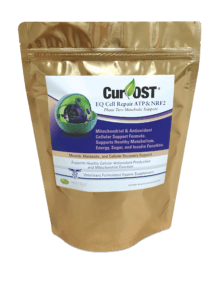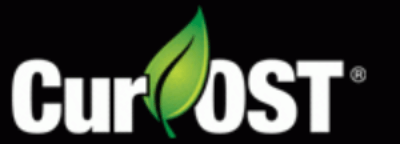In order to compete, run, jump, recover from an injury, muscle stiffness, PSSSM, or even battle the effects of metabolic syndrome, a horse is completely reliant upon their cells. Now, this may be obvious, as all tissues are composed of different cell types, but for most, the negative events you are encountering in your horse are actually due to those cells not functioning correctly. They are damaged and in need of desperate repair. As a result of their reduced function, other vital areas of your horse’s health are also impaired. How do you repair the cells and turn the tide on this viscous cycle of events? The Cur-OST EQ Cell Repair formula may just be the answer you are seeking!

There are all sorts of injuries that occur in the working horse, involving joints, to hooves, and tendons. In addition, there are a host of medical ailments that many owners are contending with in their horse, from metabolic conditions, to insulin resistance, Cushing’s disease (PPID), PSSM, and overall poor immune function. Outside of these injuries or ailments, you have performance and stamina in the horse, which can be a major problem for many in the racing industry, barrel racing, jumping, and dressage worlds. Many of these equine competitors may lack the overall desired stamina or indeed, perform okay, but their recovery is lacking and associated with overall muscle soreness and pain.
What is the common denominator?? Cellular function!
For the working or competing horse, proper cellular function is needed to:
- Produce energy or ATP
- Remove toxic byproducts that have accumulated (lactic acid)
- Produce internal antioxidants to counteract free radicals
- Dilate blood vessels and properly distribute blood circulation
For the horse with medical complaints or injuries, proper cellular function is needed to:
- Produce energy or ATP
- Support the immune response
- Remove toxic byproducts as a result of infection or improper cell function
- Properly distribute blood circulation
- Support normal insulin production and glucose metabolism
The bottom line? Horses in both categories are completely reliant upon proper cell function to improve their performance, recovery, circulation, immune health, energy production, hoof health, tendon health, and proper utilization of insulin and glucose.
Does Your Horse Have Cellular Dysfunction?
Every horse is reliant upon proper cell function, just as we are as humans. The body cannot function if the cells within it are not working properly. The body cannot heal or mend if the cells within it are not working properly.
So, how does one tell if their horse has issues in this area of cellular health and function?
To be honest, any time there is an injury, poor performance, failure to recover, poor insulin function, laminitis, joint disease, or any other health malady in the horse….there is poor cellular function. Now, the question comes regarding to what degree and what is the best approach to be used?
Cellular function and health can be supported in a multitude of ways. A clean, well balanced and nutritious diet is one way and should be the baseline approach for all of these horses. Then, in addition, almost every one of our Cur-OST equine formulas address cellular function, either through balancing of the inflammatory response, antioxidant support, or provision of natural nutrients. So, through these approaches, cellular function in the horse is supported and encouraged.
However, some horses continue to struggle and fail to recover. These are the ones that I target and look at more closely, for this indicates one of two things:
- Something in the current regimen is fighting us and producing harm for the horse
- Cellular damage is beyond the current regimen and requires a higher level of support
In our facility, I can look at cellular function in the horse more specifically, in terms of evaluating blood levels of antioxidants and free radicals. In many horses that I have encountered, with performance issues, injuries, or metabolic conditions, the levels in the blood of both are often below normal. This is not a good thing and indicates poor cellular function. When we step in on a higher level and support that cell, the levels on repeat blood assays are higher and returning to normal levels. This then usually equates to a clinical response in the horse.
Cur-OST EQ Cell Repair; Taking Advantage of Clinical Research
In our equine rehabilitation program, many of the horses presented suffer from chronic conditions impacting them for years. The prior owners have exhausted their efforts on everything from special shoes, to medications, supplements, and even regenerative therapies including stem cells, IRAP, and PRP therapy. The horses just failed to respond, or responded slightly then went back down hill. They are very challenging cases, because in that time frame, there is marked cellular damage, bone changes and alterations in blood distribution patterns.
In all cases, we start with a clean and nutritious diet, along with a baseline of Cur-OST supplements to target the horse’s obvious problems. Some respond and do well, while others improve but then seem to hit a plateau in their recovery. More recently, I have begun to explore those horses with assays for free radicals and antioxidants in their blood, and to my surprise, almost all of them were low which indicated cellular ‘hypo-function’. We expect and need a certain level of free radicals and antioxidants present within the horse’s body, as this stimulates the immune response and keeps your horse healthy. In these horses, the levels were often well below normal, so that equates to a lowered cellular production of energy (ATP), lowered production of internal antioxidants (GSH, SOD), and a lower immune response. This then leads to a reduced level of recovery and healing for the horse.
So, how do you get them to ‘recover’ in their cellular health, when other basic measures have failed to produce a response?
In seeking a solution for our horses, Cur-OST EQ Cell Repair was created. This is a unique formula because it utilizes 4 main ingredients:
- Astaxanthin 1.5%
- Acetyl-Carnitine
- Ascorbic Acid
- Alpha Lipoic Acid
Now, one may look at this list and recognize some of the ingredients and then determine that they could just use one or the other, or maybe just use another antioxidant, like vitamin E. However, while this may seem simple, it is not, as discussed in the vitamin E article. There is a reason why many horses with EPM or PSSM fail to respond or indeed, actually get worse, when put on high doses of vitamin E, when used as a solo-therapy.
“Antioxidant support is needed in those medical and injury cases, as noted by the improper cellular function, however, it is wise to evaluate your approach to providing those antioxidants.”
In the creation of the Cur-OST EQ Cell Repair formula, I knew the equine patients in our care required antioxidant support, but they were already on antioxidants in the form of herbs, food sources, and even isolated antioxidants, including CoQ10 and Vitamin E. Still, they failed to respond clinically and on repeat blood panels. These horses required something more and in research, we often find our answers.
Most of these cases, in our facility and abroad, have pretty significant cellular damage. One byproduct of this damage is reduced internal antioxidant production, which is needed to protect the cells against free radical damage, but also to ‘recharge’ other antioxidants produced by the body or taken in via the diet or supplements. So, if this cellular damage is significant enough, based on blood panels, then any antioxidants provided to them may actually induce more harm than good, due to lack of the ‘recharging’ effect. This is especially noted when you choose to just use one isolated antioxidant, such as vitamin E, in your horse.
“An antioxidant becomes a free radical as it donates an electron in the chemical reaction. It must be recharged by internal defenses, otherwise, it can induce more harm upon your horse’s body.”
The four ingredients found in the Cur-OST EQ Cell Repair provide antioxidant support, on a very high level, especially in combination with one another. One key thing is that two of them, being Astaxanthin and Lipoic Acid, do not require internal recharging by the body, so in a situation with reduced cellular function, the chance of them doing harm as they donate electrons is much reduced. This act or benefit, helps to protect the cells in your horse and support their recovery.
In addition, vitamin C is included for obvious antioxidant support in synergy with the other ingredients. While it is true that horses can produce their own internal vitamin C, it is noted in my laboratory, based on urine levels, that many of these horses have either lost this capacity or unable to produce enough to counteract the damage present in the body. This is a supply and demand type of situation.
Acetyl-L-Carnitine is added for it’s multitude of clinical benefits to the horse. Acetyl-L-Carnitine is a unique form of carnitine and is used to encourage proper fatty acid metabolism for energy, but also provides significant antioxidant support, and supports cellular function on many levels including the muscles and neurological system.
Two of the ingredients, Acetyl-Carnitine and Astaxanthin, were demonstrated in a research project on Thoroughbreds in training, to reduce muscle associated increases in CK enzyme, likely through antioxidant and fatty acid metabolism support. This likely then impacts their training, performance, and recovery and could prove very useful for horses afflicted with other muscle associated myopathies including ‘tying-up’ or PSSM.
The Bottom Line in Horse Cellular Health?
The bottom line to me, at least in my clinical position, is that I have to help that horse to mend, recover, or improve in their overall performance. While basic Cur-OST approaches help upwards of 80% of them, many horses are still left wanting and desiring more. This is mainly due to the extensive cellular damage present. This also applies to many other horses that I consult with that continue to contend with other issues from foot pain, to tendon injuries, or metabolic or muscle conditions that fail to respond or improve fully.
Cur-OST EQ Cell Repair has helped many of our patients reach that higher level of recovery. This formula works in many ways, and as noted, works directly to improve cellular function, energy (ATP) production and antioxidant provisions. The increase in internal antioxidant production is often through a genetic transcription factor, termed NRF-2, which some may be familiar with. Certain herbs and antioxidant ingredients stimulate and support this NRF-2 factor, which then results in increased levels of internal antioxidant production by your horse’s body. This then opens the road to recovery for your horse.
Given the levels of ingredients provided in the formula, which is based on research dosing, it can be somewhat expensive indeed. However, for myself, in our program, it has become a gold standard for many equine cases, sometimes being used alone for the first month or combined with other Cur-OST equine formulas. My goal is to re-establish cellular health in the horse, in that patient. Once blood panels and markers are returning to normal, I will often reduce the dose and rely more on other formulas to continue to support that horse, with continued monitoring. For some, this approach works, while for others, the cellular damage is extensive and the cells require a long period of time on the formula.
If you are encountering ongoing problems in your horse, take a look at the Cur-OST EQ Cell Repair formula and see if it might provide an increased level of support!
Author: Tom Schell, D.V.M, CVCH, CHN



Good Morning 🙂
Is this product available in Australia please?
My horse has a severe tendon injury. Would this product help with that?
Hi Ann, Yes, this formula could prove useful in a tendon situation. Thank you.
I have a horse with breathing problems . Would this help
Woudl this help a horse with both Chronic Lyme and PSSM2/MIM?
Yes. Thank you.